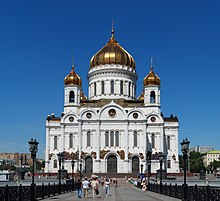Our website is made possible by displaying online advertisements to our visitors.
Please consider supporting us by disabling your ad blocker.
Cathedral of Christ the Saviour
| Cathedral of Christ the Saviour | |
|---|---|
Храм Христа Спасителя Khram Khrista Spasitelya | |
 The new Cathedral of Christ the Saviour as viewed from the bridge over the Moscow River | |
| 55°44′40″N 37°36′20″E / 55.74444°N 37.60556°E | |
| Location | Moscow, Russia |
| Denomination | Russian Orthodox |
| Website | www |
| History | |
| Consecrated | 19 August 2000 |
| Architecture | |
| Style | Russian Revival |
| Specifications | |
| Capacity | 9,500 people[1] |
| Length | 79 m[1] |
| Width | 79 m[1] |
| Height | 103.4 m (top cross)[2] 91.5 m (top dome)[2] 69.5 m (dome ceiling)[2] |
| Nave height | 37 m (interior)[1] |
| Other dimensions | 194,900 m3 [2] |
| Floor area | 3,980 m2[3] |
| Dome diameter (outer) | 29.8 m[2] |
The Cathedral of Christ the Saviour (Russian: Храм Христа́ Спаси́теля, romanized: Khram Khristá Spasítelya, IPA: [xram xrʲɪˈsta spɐˈsʲitʲɪlʲə]) is a Russian Orthodox cathedral in Moscow, Russia, on the northern bank of the Moskva River, a few hundred metres southwest of the Kremlin. With an overall height of 103 metres (338 ft),[4] it is the third tallest Orthodox Christian church building in the world, after the People's Salvation Cathedral in Bucharest, Romania, and Saints Peter and Paul Cathedral in Saint Petersburg, Russia.
The current church is the second to stand on this site. The original church, built in the 19th century, took more than 40 years to build, and was the site of the 1882 world premiere of the 1812 Overture composed by Tchaikovsky. It was destroyed in 1931 on the order of the Soviet Politburo. The demolition was supposed to make way for a colossal Palace of the Soviets to house the country's legislature, the Supreme Soviet of the USSR. Construction started in 1937 but was halted in 1941 when Germany invaded the Soviet Union during World War II. Its steel frame was disassembled the following year, and the palace was never built. Following the dissolution of the Soviet Union, the current cathedral was constructed on the site between 1995 and 2000.
- ^ a b c d "Храм Христа Спасителя". Archived from the original on 27 July 2020. Retrieved 12 February 2019.
- ^ a b c d e "Основные размеры Храма Христа Спасителя".
- ^ Sidorov, Dmitri (2000). "National Monumentalization and the Politics of Scale: The Resurrections of the Cathedral of Christ the Savior in Moscow". Annals of the Association of American Geographers. 90 (3): 548–572. doi:10.1111/0004-5608.00208. ISSN 0004-5608. JSTOR 1515528. S2CID 144856387.
- ^ "ХРАМ ХРИСТА СПАСИТЕЛЯ". www.xxc.ru. Archived from the original on 2 December 2010. Retrieved 5 January 2018.
Previous Page Next Page
Katedraal van Christus die Verlosser AF كاتدرائية المسيح المخلص Arabic كاتدرائية المسيح المخلص ARZ Храм Хрыста Збавіцеля BE Христос Спасител (Москва) Bulgarian Catedral del Crist Salvador Catalan КӀелхьараваккхархо волу Ӏийсан Килс CE Katedrála Krista Spasitele (Moskva) Czech Eglwys Iesu'r Gwaredwr CY Frelseren Kristus-Katedralen Danish



